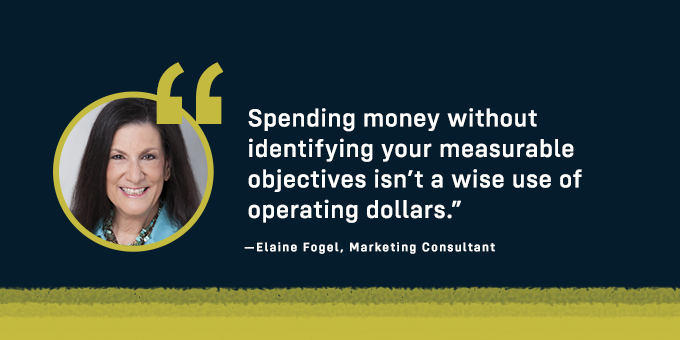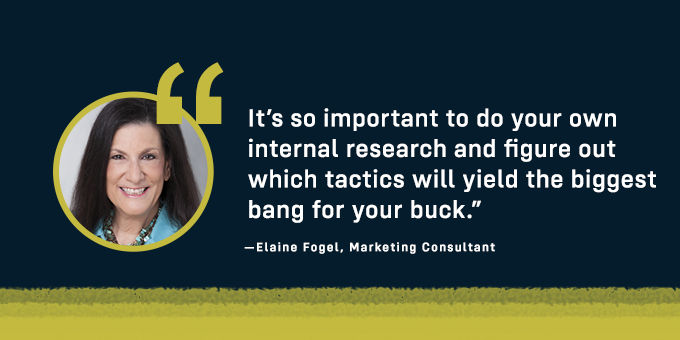
Are you basing your nonprofit marketing budget on trends and assumptions? You owe it to your donors, volunteers, employees, and mission to allocate your funds wisely. That’s why it’s critical to develop a strategic marketing plan based on internal metrics.
POV Solution provides print and print-related services to nonprofits around the country. But we also like to share marketing insights from experts outside of the print industry that can help nonprofits function more successfully.
“Spending money without identifying your measurable objectives isn’t a wise use of operating dollars. That’s true for any organization, but especially for nonprofits,” says marketing consultant, speaker, and author Elaine Fogel.
She adds that too many nonprofits make assumptions about what their marketing efforts should be—rather than basing their decisions on what will work best with their target audiences.

Fogel’s experience includes managing the marketing efforts—and large budgets—of major nonprofits like the March of Dimes of Canada and the Canadian Breast Cancer Foundation. For nearly 15 years, she’s been president of Solutions Marketing & Consulting, a Phoenix-based marketing and branding agency.
So how do you push past the assumptions and start budgeting for your nonprofit marketing efforts more effectively? The following 3 key insights from Fogel can help:
- Understand what it takes to create a targeted, data-backed marketing budget
- Realize the assumptions that may be influencing—and harming—your marketing efforts
- Start doing internal research so you have metrics for what does and doesn’t work for you
Below we’ll explore each one in depth.

1. Understand What it Takes to Create a Targeted, Data-backed Marketing Budget
Your marketing budget should be determined by metrics. That’s why Fogel’s idea of a marketing plan goes well beyond a simple strategic plan.
“Lots of nonprofits have a strategic plan, which can be great for providing a roadmap. But it doesn’t give you the concrete information you need for a marketing budget,” says Fogel.
To create a more effective budget, your marketing plan should answer critical questions like these:
- Goals: Where do we want to go? Where do we see our organization in a few years? How can we state these goals in quantifiable ways?
- Strategies: How are we going to get there? What is it going to take?
- Metrics: How are we going to measure our efforts? How do we know if we’ve achieved our goals?
Taking these steps—especially measuring your performance—will help you know if your budget spend is producing a good return.
But Fogel says this isn’t just about fundraising revenue. For nonprofits, this includes calls to action for events, advocacy efforts, or wherever you want people to respond.
2. Realize the Assumptions That May be Influencing—and Harming—Your Marketing Efforts
So why is it so many nonprofits lack a budget that allocates funds based on solid strategies and measurable results? Fogel says that many organizations assume that what’s trending or popular will work for them, too.
And perhaps the biggest example of this is the massive migration to digital. Much like the business sector, most nonprofits today are pouring more and more of their budget dollars into digital marketing efforts—e.g., website design and maintenance, content marketing, social media, etc.
Fogel says one reason they may be doing this is because they assume they’re going to get greater return on investment compared to traditional offline efforts like print.

“That’s now the conventional wisdom. But is it really true for them? It depends. That’s why it’s so important to do your own internal research and figure out which tactics will yield the biggest bang for your buck.”
Fogel hastens to add she’s not saying nonprofits shouldn’t be doing digital marketing. “That would be ridiculous,” she says. “But you need to leverage digital’s strengths strategically.”
Take the Internet’s incredible reach, for example. Fogel points out that a lot of nonprofits have locally-based missions. “For them, greater reach is still going to be in their own backyards,” a fact that needs to be accounted for through strategic marketing efforts.
Consider the Evidence That Undermines Your Assumptions
Let’s continue with the example above on digital marketing. We’ve isolated at least one big assumption, namely that some digital marketing’s ROI makes doing it a no-brainer compared to traditional marketing.

But you need to take the all-important next step: Make a good-faith effort to find evidence that calls the assumption into question. Are there surveys, studies, and reports with information that undermines your assumption?
Of course, says Fogel, you should note the source of your evidence and take self-serving results with a grain of salt. On the other hand, when you can start to pile up a variety of information that runs counter to your assumption, it’s time to pause and reconsider what’s driving your marketing budget.
Look at what we find when we put our digital marketing assumption under scrutiny. There’s no doubt that the internet has influenced a wide range of consumer behavior. Yet Fogel says in some ways we may be reaching a point of oversaturation, especially when you consider statistics like the following:
- Stagnant growth. The 2019 M+R Benchmarks Study tells us that nonprofit online revenue for 2018 increased by just 1%, stating, “This marks the first time in 13 years . . . that we are reporting average revenue growth in the single digits.”
- Discouraging email response rates. When it comes to email fundraising, M+R says that “nonprofits are facing serious challenges.” For example, findings include a reduction in response rates for advocacy emails (1.8%, down by 15%) and fundraising emails (.06%, down by 13%).
- Digital’s dominance not so clear-cut. In the Donor Mindset Study, nonprofit donors were asked which method of communication they prefer, email or direct mail. In short, donors were almost evenly divided in their responses with 37% favoring direct mail, 35% email, and 28% saying either would be okay.
- Weaker trust in digital. A MarketingSherpa survey found that three of the top five most trusted advertising channels were either print or signage (the other two were TV and radio ads).
- Everyone is not on the internet. The Pew Research Center reports that 1 in every 10 adults in the US (+25 million people) doesn’t use the Internet, a number that has actually remained steady for the past four years despite various efforts to encourage internet use in underserved regions.
The moral here? Our marketing assumptions can hurt! In this case, just because digital seems easy, popular, or cheap, doesn’t mean it’s always effective.
3. Start Doing Internal Research So You Have Metrics for What Does and Doesn’t Work
Here’s where you can really break free from your marketing assumptions: Conduct internal research so you can ultimately allocate your marketing budget based on data that reflects what’s true for your target audiences.
This will also propel you past multichannel marketing based on hope. In other words, using everything from blogging, enewsletters, and social media to events, post card mailers, and donor brochures isn’t inherently a smart strategy. You still need to know how effective each one is.
If you can afford outside consulting, there are agencies that specialize in helping clients measure their marketing efforts, says Fogel.
But she adds this: “I’m not saying every nonprofit can afford to do rigorous research on the effectiveness of their marketing efforts, but there are ways to do it inexpensively,” says Fogel.
For example, she suggests methods such as the following:
- Phone surveys. Conduct phone surveys using a bank of volunteers calling to find out how donors like to receive information about your organization.
- Survey software. For the same information, use a free or low-cost survey software such as SurveyMonkey.
- Newsletter surveys. If you send out a print newsletter, include a detachable survey to fill out, and if you do an email newsletter, include a link to the survey.
- Online metrics. Become an expert at using Google Analytics and/or use services designed to measure your marketing ROI. (Kissmetrics, Marketo, and RapidMiner are a few examples.)

“When you can somehow quantify your marketing efforts, it’s going to drive you to make smarter and smarter budget decisions. That ultimately benefits everyone,” says Fogel.
If you’d like more information about Fogel’s insights and services, visit her website.
Interested in learning how POV Solution can help your nonprofit use print more strategically? Contact us today!

